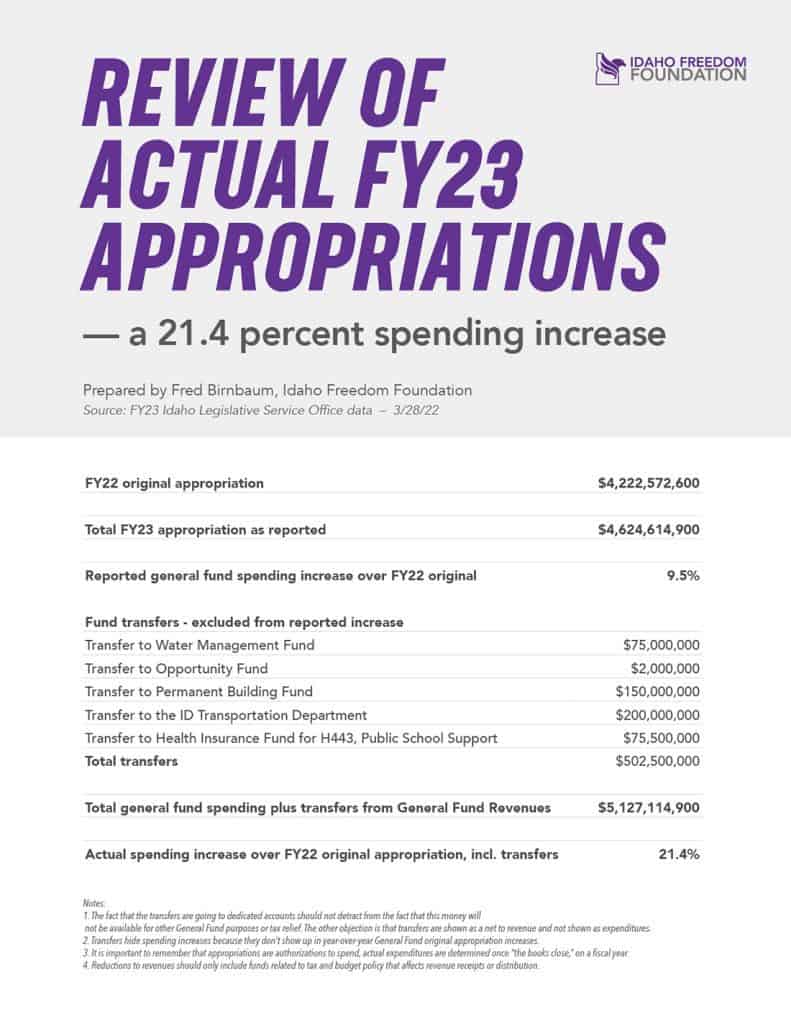


It is hard to find the superlatives to properly describe Idaho’s new budget, which takes effect July 1. It’s breathtaking in terms of the sheer size of the increase, abetted with the infusion of billions of dollars of federal money via the COVID relief fund pipelines.
Idaho has seen a massive infusion of federal funding via COVID relief packages like the America Rescue Plan Act. This funding has swelled total state spending up 47.5% from an actual $8.75 billion in FY20 to an estimated $12.9 billion in FY23.
While Gov. Brad Little and legislative leadership will report a 9.5% increase in general fund appropriations from fiscal year 2022 (FY22) to fiscal year 2023 (FY23), the actual number is 21.4%.

How did a supposedly fiscally conservative state grow the budget in one year by such a staggering amount?
Most state spending reporting focuses on general fund dollars, which are derived primarily from individual and corporate income taxes and sales and other excise taxes. These funds get spent on education, public safety, welfare, and other government programs. Agencies that don’t use general funds include Idaho Fish and Game, which uses dedicated funds from hunting and fishing licenses. These dedicated funds rarely get much discussion.
Sprinkled throughout most agencies that receive money from the general fund are federal funds. And therein lies a large part of the problem.
Prior to COVID in FY20, the actual state expenditures of all general, dedicated, and federal funds were $8.75 billion. COVID relief funds swelled the actual expenditures in FY21 to $10.23 billion, a 16.9% increase. One of the detrimental effects of this surge of federal funds is that it allowed agencies to grow spending more than they would without dipping into general fund revenues. The actual general fund expenditures for FY21 were lower than in FY20, but federal funds increased $1.45 billion.
Gov. Brad Little touted Idaho’s robust economic recovery from COVID and the surge of new residents when he informed the public about the record $1.9 billion budget surplus. These were factors to be sure, but the federal windfall impacted just about every state; even historically profligate states like California reported record revenues.
With the state awash in money, Little started the session with a $601 million income tax rebate and rate cut. Seemingly satisfied with that one action, he ignored calls to reduce property taxes or remove the sales tax on food. The Joint Finance-Appropriations Committee got the message and went beyond his request with even bigger budgets.
But how does a 9.5% increase really equate to 21.4% increase?
When Gov. Butch Otter was in office, specifically during his last term, it was becoming embarrassingly obvious that the former adherent to liberty and limited government had thrown in the towel and embraced big government. But wanting to stick to his own maxim of not growing government faster than personal income, his administration increasingly used deduction from revenues, known as transfers, to make the appropriation growth look smaller.
In short, Otter and company used accounting gimmicks to hide massive spending hikes.
Essentially, money was shifted from general fund revenues directly to dedicated accounts bypassing the general fund appropriation totals. Prior to COVID, Little largely abandoned this practice. However with the surge of revenues overflowing state tax coffers, the temptation returned. Over $500 million for FY23 of what should have been shown as appropriations was simply deducted from revenues. Examples include money for water projects, buildings, transportation projects and a teacher health insurance fund.
There are legitimate transfers of revenues, such as rainy day funds, but the governor overreached by pushing these rainy day funds (known as budget stabilization funds) to a projected $1.2 billion, far more than what was needed.
But aren’t we in an inflationary environment which requires higher spending? Yes and no. The annual budget is developed from a base starting point for each agency. The line items from the starting point to get to a maintenance level budget include inflationary adjustments, benefit cost adjustments, and pay raises. What plagued this budget was the hundreds of millions in spending for new line items that came after the inflationary adjustments and had nothing to do with inflation.
Let’s look at House Bill 827, the fifth and final budget bill for the Idaho Commission on Libraries, to understand the process. This budget came under scrutiny because of the availability of pornographic and obscene materials to minors in the library system. This budget had a base level spending of $6 million for FY23. Added to that total was about $237,000 in benefits, inflationary adjustments, and pay increases. Beyond those were $1.47 million in line items including a bilingual project coordinator, additional federal grants, and digital access. Over 97% of this extra money is sourced from federal funds.
These line items come on top of a $2.3 million federal infusion last year to provide grants to support programs like “Libraries Keep Students Learning and Adults Earning” and “digital equity.” It was through this federal pipeline that pornographic resource materials became more available.
Idaho has seen a massive infusion of federal funding via COVID relief packages like the America Rescue Plan Act. This funding has swelled total state spending up 47.5% from an actual $8.75 billion in FY20 to an estimated $12.9 billion in FY23.
The governor and legislative leadership will insist that because much of this increase is from federal money, it won’t alter the state’s long term spending patterns. But it is hard not to conclude that we are in new territory based on what we see with individual agency budgets, including headcount additions and new programs.
We are now a state that balances its budgets on the back of borrowed federal funds pumped into our educational and health care systems, with no exit strategy if federal funding returns to pre-COVID levels.

